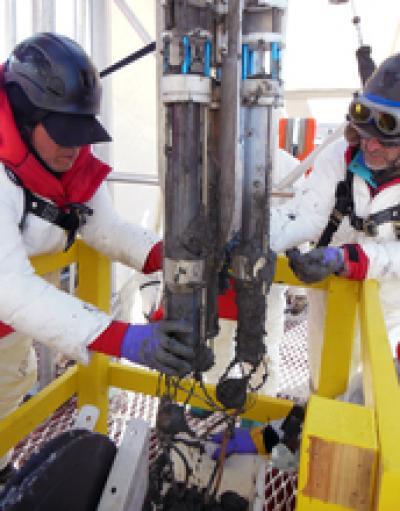Humans don't want to live above the West Antarctic ice sheet but microbes can certainly live below it, according to a new study. Even half a mile below it.
The waters and sediments of a lake 2,600 feet beneath the surface of the West Antarctic ice sheet support "viable microbial ecosystems", according to recent results. Given that more than 400 subglacial lakes and numerous rivers and streams are thought to exist beneath the Antarctic ice sheet, such ecosystems may be widespread and may influence the chemical and biological composition of the Southern Ocean, the vast and biologically productive sea that encircles the continent.
Many members of the
microbial community
can mine rocks for energy and use carbon dioxide as their source of carbon.

Brent C. Christner (right), of Lousiana State University, and Alex Michaud, a graduate student at Montana State University, retrieve the first water sample from Antarctica's subglacial Lake Whillans. Credit: Reed Scherer, Northern Illinois University
According to Brent C. Christner, the paper's lead author and a researcher with the NSF-funded Whillans Ice Stream Subglacial Access Research Drilling (WISSARD) project, "Hidden beneath a half-mile of ice in Antarctica is an unexplored part of our biosphere. WISSARD has provided a glimpse of the nature of microbial life that may lurk under more than 5 million square miles of ice sheet."
Analysis of the samples taken from subglacial Lake Whillans, the researchers indicate, show that the water contains a diverse microbial community, many members of which can mine rocks for energy and use carbon dioxide as their source of carbon.
Definitive evidence of life in subglacial lakes
Analysis of the samples taken from subglacial Lake Whillans
led to the realization that a vast aquatic system of rivers and lakes exists beneath the ice in Antarctica has spurred investigations to examine the effect on ice-sheet stability and the habitability of environments at the bed. The latest WISSARD announcement is the first to provide definitive evidence that a functional microbial ecosystem exists beneath the Antarctic ice sheet, confirming more than a decade of speculation about life in this environment.
Using various methods, including airborne radar surveys, scientists have built a knowledge base about Antarctica's subglacial hydrological system over the past 40 years. The largest of the subglacial lakes, subglacial Lake Vostok in East Antarctica, is one of the largest lakes on our planet in terms of volume and depth and has been isolated beneath the ice sheet for more than 10 million years.
Samples of microbes from Lake Vostok have been collected indirectly by examining ice collected above the liquid part of the Lake- ice that refroze--accreted--on the bottom of the ice sheet.

Ross Powell (left) and Reed Scherer, both of Northern Illinois University, recover an instrument from subglacial Lake Whillans. Credit: Reed Scherer, Northern Illinois University
These samples, which were described in 1999 by Priscu, the chief scientist of the WISSARD project, and David Karl of the University of Hawaii, presented the first evidence for life beneath the huge Antarctic ice sheet.
However, the drilling techniques used to retrieve the Vostok samples and the low amount of microbial biomass present in the samples had called into question previous studies that concluded the lake supports a living ecosystem.
The WISSARD team drilled into subglacial Lake Whillans using a clean hot-water drill and incorporated rigorous measures to avoid the introduction of foreign material into the lake.
The approach to drilling was guided by recommendations in the 2007 National Research Council-sponsored report, "Exploration of Antarctic Subglacial Aquatic Environments: Environmental and Scientific Stewardship," aimed to protect these unique environments from contamination.

Ken Mankoff of the WISSARD project monitors a borehole camera. Credit: Reed Scherer, Northern Illinois University
A team of engineers and technicians directed by Frank Rack of the University of Nebraska-Lincoln, designed and fabricated the specialized hot-water drill that was fitted with a filtration and germicidal UV system to prevent contamination of the subglacial environment and to recover clean samples for microbial analyses. In addition, the numerous customized scientific samplers and instruments used for this project were also carefully cleaned before being lowered into the borehole through the ice and into the lake.
A major concern that drove the clean-drilling techniques and protocols is that it is still unclear how interconnected the subglacial aquatic system is. Researchers did not want to risk contaminating the entire system through their sampling of one body of water.
The newly published paper also raises a separate issue of the connectivity of Lake Whillans to the wider global ecosystem, noting that the lake is part of network of three major reservoirs beneath the Whillans Ice Stream that regulate the transportation of water to a subglacial estuary--an area where fresh and salt water mix--which links the subglacial aquatic system to the ocean beneath the Ross Ice Shelf.
"Given the prevalence of subglacial water in Antarctica," the researchers write, "our data...lead us to contend that aquatic microbial systems are common features of the subsurface environment that exists beneath the ... Antarctic ice sheet."




Comments